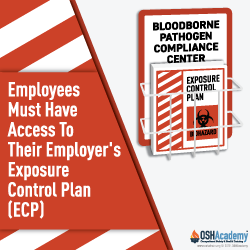Exposure Control Plan (ECP)
An Employer's Exposure Control Plan
An employer exposure control plan (ECP) is a requirement of 29 CFR 1910.1030(c) of the Bloodborne Pathogens Standard established by the Occupational Safety and Health Administration (OSHA). The purpose of the ECP is to establish procedures to eliminate or minimize employee exposure to bloodborne pathogens.
Does Your Employer Have an Exposure Control Plan?
A written ECP outlines the strategies necessary to eliminate or minimize employee occupational exposure to bloodborne pathogens. This site-specific plan identifies all employee classifications which have occupational exposure to bloodborne pathogens and other potentially infectious materials.
Additional components of an ECP are:
- engineering and work practice controls
- personal protective equipment (PPE)
- housekeeping
- containment and labeling of potentially infectious materials
Another key component of the plan includes listing the site-specific means by which the facility will reduce the employee risk. These methods include appropriate training, the communication of hazards, hepatitis B vaccinations for any employee who has occupational risk of exposure, methods for post-exposure evaluation and follow-up, proper recordkeeping, and a sharps injury log.
Knowledge Check Choose the best answer for the question.
4-1. The purpose of the Exposure Control Plan (ECP) is to _____.
You forgot to answer the question!

